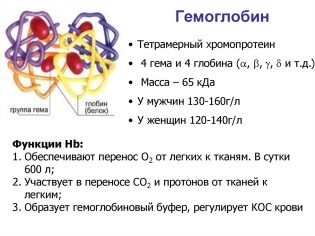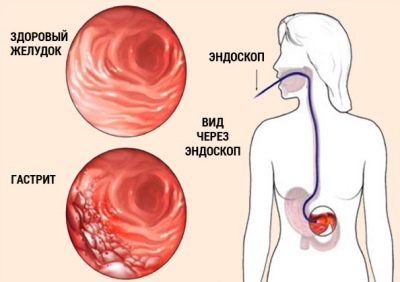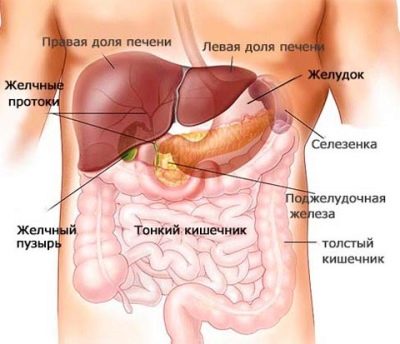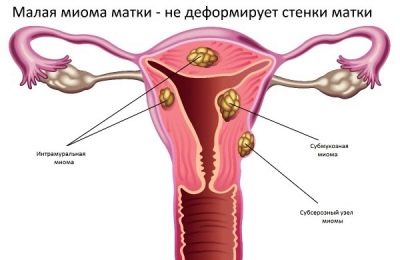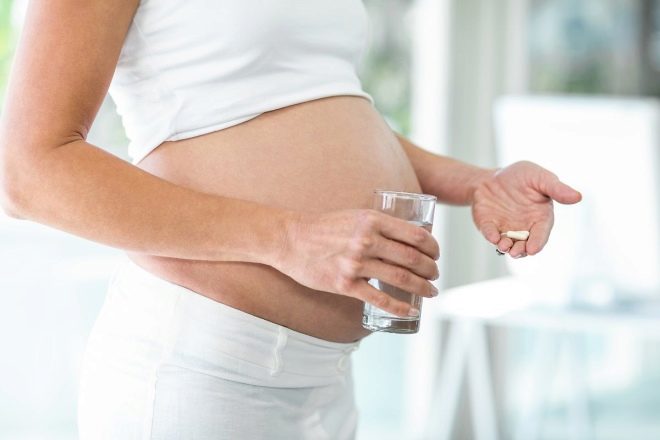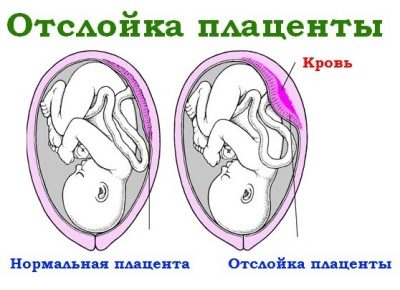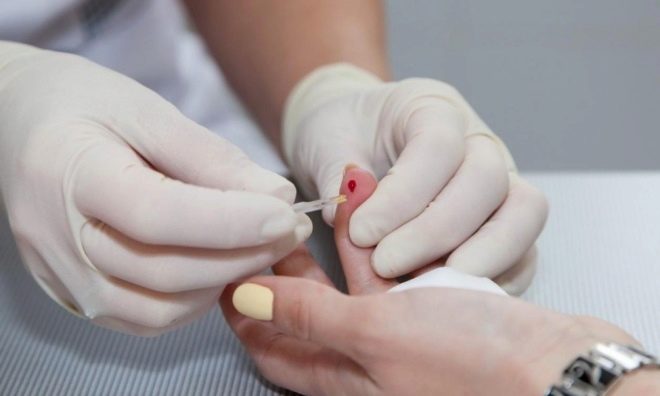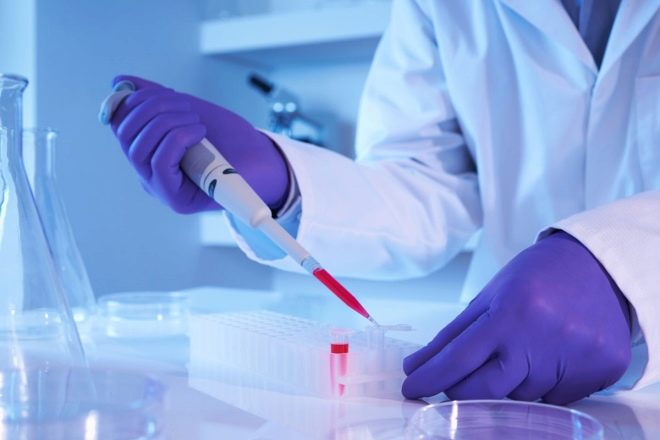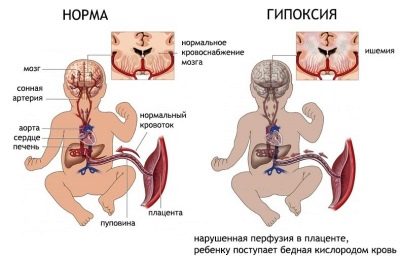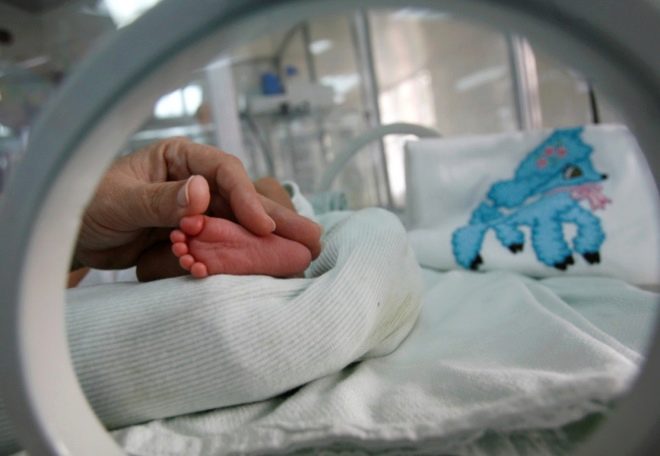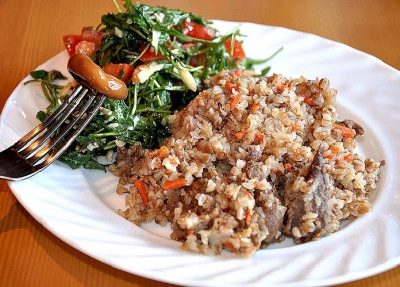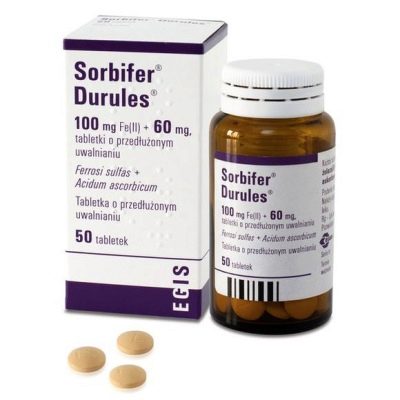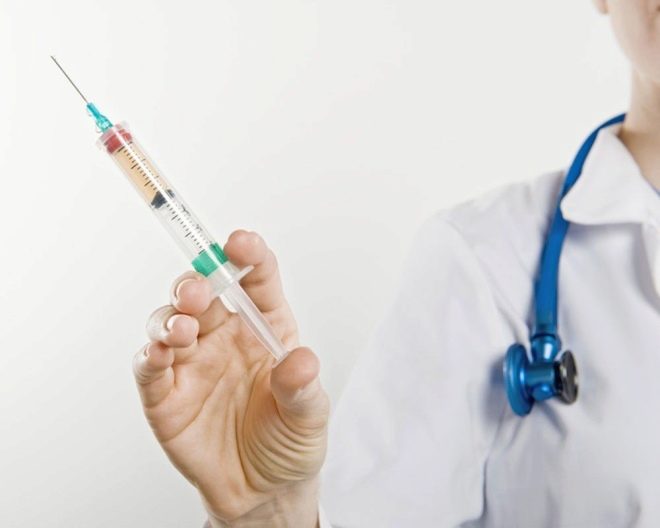Causes of low hemoglobin during pregnancy, products and drugs to increase it
Blood pathologies that appear during childbirth are extremely unfavorable and dangerous. You can identify them using simple laboratory tests.
Purpose of the study
To function, the baby growing up in his mom's tummy needs daily nutrients and oxygen. He gets all this through a common blood flow system with his mother. These biologically active substances are transferred by red blood cells called red blood cells.
Inside such cells there is hemoglobin. This is a special protein, which contains an organic component and iron. It is this composition that allows hemoglobin to provide the full range of its actions. He not only transfers organic components to the internal organs of mother and baby, but also participates in many processes as a natural catalyst.
When carrying a baby often there are situations when hemoglobin falls. Such physiological processes develop, as a rule, at the end of the 2nd trimester and in the 3rd trimester. This is due to the physiology of the developing body of the baby. Increased need and leads to the formation of anemia in remote weeks of fetal development.
The degree of pathologies encountered is different. This division became the basis for the classification of anemia, which is used by doctors of different specialties when interacting with future moms. This determines the tactics of treatment and further observation.
Mild severity of anemia is accompanied by a decrease in the rate below 110. This condition is quite often manifested in future moms at 36-38 weeks of pregnancy. In the first trimester, such violations are quite dangerous and require mandatory treatment to the therapist for advice.
With a decrease in hemoglobin from 90 to 70 g / liter, specialists speak of an anemic condition of moderate severity. This is a more unfavorable state. In no case should this clinical sign be ignored. Failure to provide medical assistance at this stage can lead to the development of very dangerous pathologies for the life of the fetus.
If hemoglobin drops below 70 g / liter, then this symptom can already be considered a manifestation of a severe course of anemia. In this case, the pregnant woman is hospitalized in the hospital for intensive treatment. In such a situation, as a rule, the prescription of iron-containing preparations, which are administered by injection, is already required.
Reasons for the decline
Exposure to a variety of causes can lead to a decrease in hemoglobin in the blood of a pregnant woman.In some cases, anemia is present in the expectant mother before pregnancy. Immediately it is worth noting that in the absence of treatment this condition will only worsen. The prognosis of the development of pathology in this case is unfavorable.
Physiological decline in hemoglobin may develop not only in the later stages of pregnancy. Also, this condition is quite common in future moms who are carrying twins or triplets. During multiple pregnancies, the need for oxygen and nutrients increases by 40%.
Doctors allocate a lot of different pathologies, which are accompanied by a decrease in hemoglobin. Pregnancy is a special time. During this period, diseases in both the mother and the prenatal development of her baby can lead to the development of an anemic condition.
The tendency to anemia is quite often congenital. If a woman who is carrying a baby has problems with reduced hemoglobin, this means that her daughter will most likely have similar problems. This feature is largely due to genetic memory and features of the hematopoietic system.
Vegetarianism
Vegetarian food often leads to an anemic condition. Immediately it should be noted that women who exclude animal food from their diet before pregnancy may not suffer from anemia before conceiving a baby. The first symptoms appear in them, when the fetus is already beginning to actively grow and develop. To compensate for this condition, medications and a mandatory revision of the style of nutrition will be required, at least for the period of carrying the baby.
Diseases
Stomach
Chronic diseases of the stomach are common causes leading to the development of an anemic condition.
Especially dangerous in this case. gastritis or enteritisflowing in erosive form. The fact is that these diseases occur with the development of microbleeds. During them, a small amount of blood is regularly lost, which leads to a decrease in red blood cells and hemoglobin.
Exacerbation of gastric ulcer or duodenal ulcer can also contribute to the development of anemia in a pregnant woman. Most dangerous erosive options. In order to prevent the aggravation of these pathologies during pregnancy, doctors will recommend the expectant mother to take special medications.
Intestines
Intestinal diseases can also lead to a decrease in hemoglobin in a pregnant woman. This contributes to a violation of the absorption function of this body. Ultimately, this leads to a violation of the absorption of essential nutrients that are necessary for the synthesis (formation) of iron in the body. In such situation after a few weeks, anemia begins to form.
Dysbacteriosis
Violation of the intestinal microflora, which is called dysbacteriosis, can also contribute to the development of the anemic condition of the future mom. This happens due to insufficient intake of all necessary vitamins and trace elements.
Usually dysbacteriosis or irritable bowel syndrome develops in women with various diseases of internal organs.
Liver and blood-forming organs
Chronic pathologies of the liver and blood-forming organs can also lead to the development of an anemic condition in the future mom. In this case, there is a violation of many metabolic processes.
Diseases of the spleen can contribute to excessive destruction of red blood cells in maternal blood, which also provokes the development of her anemia.
Endocrine system
Inadequate endocrine system can also contribute to the development of anemia in the future mother. The most dangerous diseases that occurred in women before pregnancy. In this case, the obligatory consultation of the endocrinologist is required to draw up the optimal treatment strategy.
Reproductive organs
Diseases of the reproductive organs can also lead to a decrease in hemoglobin. Most unfavorable if such pathologies often worsen during the entire period of pregnancy.
As a rule, various cystic masses of the ovaries or myomatous nodes lead to the development of the anemic state. If education data during pregnancy continues to grow, decrease in hemoglobin on this background can be quite significant.
Toxicosis
In the first half of pregnancy, an anemic condition may also occur. In most cases, this leads to persistent toxicosis. In some mummies, this unpleasant and exhausting condition can last until the end of pregnancy.
Toxicosis, accompanied by severe vomiting, leads to disruption of metabolic processes and anemia.
Stress
Strong psycho-emotional stress quite often leads to metabolic disorders in the future mother's body. If a pregnant woman is constantly nervous and worried about trifles, then the work of her nervous system is disturbed. This contributes to the progression of any pathological conditions that are present in her body.
Medication intake
Some drugs have an adverse effect on hematopoietic tissue. Constant forced use of such drugs during pregnancy will help to lower hemoglobin below normal values. Most often, such manifestations provoke receiving immunosuppressive and some hormonal drugs.
Repeated labor within 2 years
Previous genera can also lead to a decrease in hemoglobin. In this case, between the birth of two babies should pass less than two years. Exhausted female body for the first pregnancy in this situation simply does not have time to prepare for the next one. This contributes to the fact that a woman appears signs of anemia.
Other reasons
Reduced hemoglobin in late pregnancy in some cases is extremely unfavorable sign. It may indicate the development of placental abruption or other pathologies in the fetus. In this case, urgent intervention by doctors is required. In some situations, it may even be necessary to carry out urgent deliveries due to the threat to the life of the baby.
Symptoms of low hemoglobin in degrees
Anemic condition during pregnancy is very non-specific. Reviews of mommies show that for a long time they didn’t suspect that their body was deficient in iron.
This violation is detected, as a rule, very suddenly - when conducting a general blood test.
Easy
The initial manifestation of the anemic state of the future mother almost does not feel. Her behavior and appearance does not change. A woman with mild anemia continues to lead a rather active lifestyle. Many future moms in this state even go to yoga for pregnant women or do other physical activities without experiencing any adverse symptoms.
Average
With the development and aggravation of anemic pathology, a woman has negative clinical signs. She starts to get tired faster. When doing the usual physical activity may feel that she needs to rest. After a quick walk or climb 1-2 stairs, such a woman appears shortness of breath and palpitations.
Subsequently, the accelerated heart rate begins to bother the future mommy, who has anemia of moderate severity, even at rest or after a little stress. Some women may also experience an arrhythmia - an episode of irregular heart rhythm.
Anemic condition is often accompanied by the development of constipation. This is a consequence of disorders in the organs of the gastrointestinal tract.Future moms with anemia of such severity complain to their doctors that without a special diet they cannot visit the toilet for several days.
Soreness in the abdomen is characteristic of the anemic condition of a more severe course. The intensity of the pain syndrome is usually insignificant. It may increase slightly after ingestion of dense food. Many women with signs of anemia complain of pain in the area below the navel.
Even during the normal course of pregnancy, a woman may experience different taste preferences. Quite often it happens that before the period of carrying a baby, the future mother did not like any particular food product, and during the pregnancy she constantly uses it.
Similar eating disorders occur with anemia. However, they are becoming quite special. A vivid manifestation is an inexplicable desire to chew on chalk. Doctors say that patients with anemia may like the sharp smell of paint. Such disorders are usually associated with a violation of many cellular reactions in the body, which are caused by anemia.
Drowsiness is increasing throughout the day. A woman can constantly feel sleepy. At night, however, there may be significant difficulties with falling asleep or the duration of sleep. Some women have nightmares. Constant lack of sleep leads to a deterioration of mood and a tendency to crying.
Heavy degree
Severe forms of the anemic state already lead to a change in appearance. The skin becomes very pale. A woman looks constantly tired, even if she did not perform any physical activity. The area of the nasolabial triangle and the area below the lower eyelids acquire a blue color.
Quite often, severe coldness of the arms and legs develops. In some cases, the limbs become constantly cold to the touch. The skin on the legs and arms turn pale. Nails become more brittle and easily exfoliate. A woman may also complain of severe hair loss and dryness.
Diagnostics
In order to detect a decrease in hemoglobin, a fairly simple laboratory test is required. It is called a general blood test. During pregnancy, this study is carried out repeatedly.
In addition to regular screening examinations, this laboratory test is prescribed for any pathologies that have arisen during childbirth. Complete blood count also allows you to monitor the development of the state against the background of prescribed therapy.
Hemoglobin is calculated in special units, which are called "g / liter". By reducing this figure below 110 g / liter, doctors already conclude that there is an anemic condition.
The rates of hemoglobin in different periods of pregnancy vary. This is largely due to the changing physiology of the fetus.
A decrease in hemoglobin in the blood is often also accompanied. falling red blood cell levels. This situation does not always develop. There are cases when the level of red blood cells remains within the normal range when hemoglobin decreases. This causes various clinical variants of anemia.
During pregnancy often develops Iron-deficiency anemia. This pathological condition is associated with insufficient delivery or increased destruction of iron in the blood.
To diagnose this pathology, doctors prescribe a number of additional laboratory tests. Such tests include ferritin, OZHSS, and the content in the blood of serum iron. Only a combination of these criteria allows doctors to establish the diagnosis of iron deficiency anemia.
Implications for the child
A decrease in hemoglobin below normal is very dangerous. Such a pathological condition adversely affects the actively developing fetus. The long course of anemia contributes to the formation of various intrauterine abnormalities.In the future, they can lead to a lag in the physical development of the baby.
Lack of oxygen and nutrients contribute to the development of hypoxia. This pathological condition threatens the development of formations of various disorders in the development of the baby.
The development of severe anemia in early pregnancy can even lead to disruption of the process of organogenesis in the fetus. This is fraught with the development of various defects and abnormalities of the internal organs in a child.
Placental insufficiency is another possible manifestation of a prolonged anemic condition. It is very dangerous. In this case, the baby does not receive the required amount of nutrients and oxygen dissolved in the blood. In the end, this will negatively affect its development and growth.
Obstetricians and gynecologists note that a severe anemic condition can lead to too early discharge of amniotic fluid. This will inevitably lead to the need for urgent obstetric aid.
If the early birth was carried out much earlier than the deadline, then in this case the birth of a baby is possible, which has significant defects and anomalies of the internal organs.
In premature babies born due to a severe anemic condition in the mother, anemia can occur immediately after birth. In this case, it will require the appointment of intensive care not only for mommy, but also for her born child.
Decreased labor during labor is another complication.which may develop in an anemic state of pregnancy. This pathology can lead to severe bleeding. Massive blood loss will only aggravate anemia. In this case, the risk of having a baby with hypoxia increases significantly.
Such born children, as a rule, have a deficiency of body weight. In the future, the kids have problems in the work of the immune and nervous system. They develop worse and grow. Such babies can also have congenital malformations.
Dr. Komarovsky will tell you about the danger of lowering hemoglobin in the next video.
How to raise hemoglobin without harm to the baby?
Regularly tested during pregnancy is very important. A hike to the clinic and a blood test is a commonplace routine procedure that allows you to identify anemic pathologies in the very early stages of their formation.
If the doctors set a decrease in hemoglobin in this test, they will make a whole range of different recommendations for the future mom. Such a complex treatment will help to increase the level of hemoglobin and bring it back to normal.
Follow medical advice should be throughout the period of pregnancy. This will prevent the progression of pathology in the late stages of carrying a baby.
Make recommendations at home still should not be. Anemia is a very dangerous condition that requires mandatory medical supervision, especially during pregnancy. Only the doctor should monitor the dynamics of the anemic state and determine the prognosis for the baby.
Therapist is treating anemia. Go It is this doctor who, if necessary, sends the future mommy to the laboratory so that she additionally passes the tests necessary for the diagnosis. In some cases, you may need to consult a hematologist. This doctor also deals with the problems of reducing hemoglobin in pregnant women.
Iron enhancement products
A very important method of treating iron deficiency in the female body during pregnancy is diet therapy. With the help of a special diet, which includes a list of iron-containing foods, you can quite easily achieve the normalization of hemoglobin in the blood. With mild anemia, good results can be achieved without prescription of drugs.
Doctors recommend expectant mothers to use a number of products that contain active iron in their composition. Record holder among them - red meat, you can eat any of its varieties. Great for beef, lamb, pork. As a source of iron can also be used bird and game
Expectant mothers should not fry meat. It is better to bake it, stew or cook it on the grill. To compensate for the iron should eat at least 1 serving of red meat or game per day. Follow this recommendation regularly.
Meat can be supplemented with vegetable salad. In the composition of vegetables there is practically no iron, but ascorbic acid (vitamin C) is present. This biologically active component allows the gland to be better absorbed in the body. For salad, you can use any vegetables. It is better to choose them according to the season.
You can also combine the main meat dish with various cereal side dishes. Barley, any kinds of legumes, as well as buckwheat and oat groats are perfect for this. These products contain quite a lot of vitamins and trace elements that have a beneficial effect on the whole body of the future mom.
Abuse cereals should not be, because they are quite high in calories.
Fruits also contain an enormous amount of vitamin C.. These excellent natural antidepressants will help maintain a good mood, and also help the gland to better digest in the body.
Doctors recommend future mothers, who have hemoglobin in their blood, eat more green apples, pomegranates and citrus. You should choose only those fruits for which the woman does not have allergies.
Berries are not only an excellent source of antioxidants. This useful delicacy contains a huge amount of ascorbic acid. Eat them should be careful, as they often lead to the development of an allergic reaction. It is better to eat berries according to the season. In winter, you can make compote or juice from frozen raw materials.
The nuts also contain iron. However, its concentration in them is much less than in red lean meat. Eat nuts should be moderate, remembering that this is a very useful, but very high-calorie product. You can add your menu with hazelnuts, walnuts and almond nuts. They will be a great snack and will not harm the female body.
Iron preparations
With the ineffectiveness of diet, doctors prescribe medication. To do this, write out iron-containing drugs. They are necessary to replenish the necessary iron, which must be regularly supplied to the female body.
The treatment regimen is selected individually. To do this, the doctor assesses the general condition of the future mother, necessarily takes into account her age and the presence of chronic pathologies of internal organs.
Usually the duration of treatment is several weeks or months. This time period is necessary to optimize the body's work and normalize the level of hemoglobin in the blood.
To assess the effectiveness of therapy, doctors resort to the appointment of laboratory tests. As a rule, indicators of the general analysis of blood are evaluated. Positive dynamics is characterized by an increase in the number of red blood cells in the blood and an increase in hemoglobin.
Folk remedy to raise hemoglobin is considered hematogen. It is worth noting that this technique can only become a prevention, but not a cure for an anemic condition. To normalize the level of hemoglobin in the blood requires the appointment of more serious iron-containing agents.
Do not prohibit doctors from eating hematogen during pregnancy for prevention.
Tablet form
Iron pills are the most common dosage forms prescribed to correct iron deficiency in the body. Among the most commonly used are: "Sorbifer", "Maltofer"," Ferrum-Lek "," Totem ". The dosage, frequency of use and duration of the course is determined by the attending physician.
While using these drugs should be remembered that they have certain side effects. So, these means paint a chair in dark color. The appearance of this symptom should not scare the future mom. The stool will acquire normal color immediately after discontinuation of the drug.
"Ferrum - Lek"
"Ferrum-Lek" - a means necessary to compensate for iron deficiency. The drug contains trivalent ferrum. This drug is prescribed, usually in the form of syrup or tablets. Absorption and its active absorption occurs in the upper intestine.
This drug is quite well tolerated. Some women get nausea and pain in the abdomen while taking this remedy. After cessation of use, these adverse symptoms disappear completely.
The drug has a good spectrum of action and increases hemoglobin in a relatively short period of time.
Sorbifer
This is another fairly effective drug used to treat anemic conditions, including during pregnancy. In its chemical composition contains iron sulfate. This tool is characterized by a rather systematic release of metabolites. Iron is well absorbed.
Side effects are quite rare. The most frequently encountered of these is darkening of the stool and nausea. Some patients also noted a violation of taste and loss of appetite. Also, the disadvantages of this drug include its high cost.
Injection forms
When erosive forms of diseases of the gastrointestinal tract to prescribe iron tablets, doctors will not. In this case, injectable dosage forms will be prescribed. They are introduced through injections.
Typically, such treatment is carried out in the clinic or more often in the hospital. Also, treatment with iron-containing preparations in the form of injectable forms is often prescribed for the critical decrease in hemoglobin below 70 g / liter. Enter more than 0.1 grams of iron per day should not be. This dose completely compensates for the body’s need for this substance.
With parenteral administration it is very important to observe single dosages. This must be done in order not to overdose the body with iron.
The introduction of injectable iron-containing drugs is fairly easy. From adverse symptoms - local manifestations.
At the injection sites, painful infiltrates often appear. Over time, they dissolve. The correct method of performing the injection of a procedural nurse will reduce the risk of infiltration.
Injectable iron preparations include: "Ferrum-Lek", "Venofer", "Ferkoven" other. Appointed such funds, as a rule, on the course reception. After a few weeks of taking these drugs, the woman begins to recover hemoglobin levels. If possible, after staging injections, doctors prescribe iron-containing tablets to the patient.
In addition to drug therapy, doctors recommend expectant mothers who have anemic conditions, normalize your daily routine. To do this, they should sleep at least 8 hours a day. Daily walks in the fresh air at a moderate pace will also have a positive effect.
Restriction of stress plays a very important role in the prevention of this pathology, especially during pregnancy.



